Reports published over the weekend accused the Taiwan Rung Cherng Suspenparts Company (TRC) of modifying and producing servomechanisms for Russia’s UMPK glide bomb system, that converts unguided aerial bombs into guided munitions and Russian manufactured versions of the Shahed kamikaze drones.
Russia has been using more than 60 UMPK (Unifitsirovannyi Modul Planirovaniya i Korrektsii) guided bombs against Ukraine daily over recent months, resulting in significant damage on the battlefield and against civilian residential and infrastructure.
JOIN US ON TELEGRAM
Follow our coverage of the war on the @Kyivpost_official.
The reports said that TRC had made at least five modifications to improve the design of the servo mechanisms on behalf of Russia’s defense industry, and that these changes were still ongoing.
On Monday, TRC vice president Chen Shu-mei said the allegations were completely unfounded which prompted the Ukrainian activist Vadim Labas, who had been one of the sources for the original accusation, to dig deeper into the issue.
What Labas uncovered was a complicated scheme to hide the true origin of the components from a Chinese company that led one sanctions expert to comment that they “had never seen such a complex scheme of double rebranding,” to hide.
While procurement documents appeared to confirm the source of the mechanisms as being the Taiwanese company, the real manufacturer of the servos was a Chinese company KST Digital Technology Limited, whose website shows it to be a specialist servo manufacturer. The company site includes servos that are identical to those found in the UMPK attachments and Russian-made Shahed kamikaze drones.

‘Russia Is Using Gas as a Weapon’ – Ukraine at War Update for Jan. 8

KST does much of its business in the US and EU markets and came up with a scheme to disguise them as the manufacturer to avoid sanctions.
After following the “paper trail” Labas found that KST said it had sold the servos to another Chinese manufacturing company called Kaiffeng Zhendaqian Technology (KZT)—this proved to be a non-existent “shell” company.
The next step in the process saw branding on the mechanisms changed from KST to TRC. The rebranded servos were then sold to another Chinese company, UNIHUI International Limited, a Hong Kong based company.
After having been rebranded, the components are transferred via intermediary firms such as Omni Trade and Dymir Trade to enterprises that are part of Russia’s defense procurement set up including those, such as the Tactical Missiles Corporation (KTRV), that are subject to US and EU sanctions
“This dual rebranding and falsification scheme is unprecedented in its sophistication,” Labas said. “It’s not just about avoiding detection but also increasing the cost of components—a price Russia seems willing to pay.”
His findings once again highlight holes in sanctions enforcement, particularly of existing sanctions, particularly against Chinese firms that continue to avoid sanctions even when documented links to Russia’s military-industrial complex are revealed.
One obvious flaw in the Chinese system is that the Rung Cherng company, which manufactures vehicle suspension systems and chassis parts and not servos also does not mark its products as TRC, a term which is only used on its English language website.
You can also highlight the text and press Ctrl + Enter






